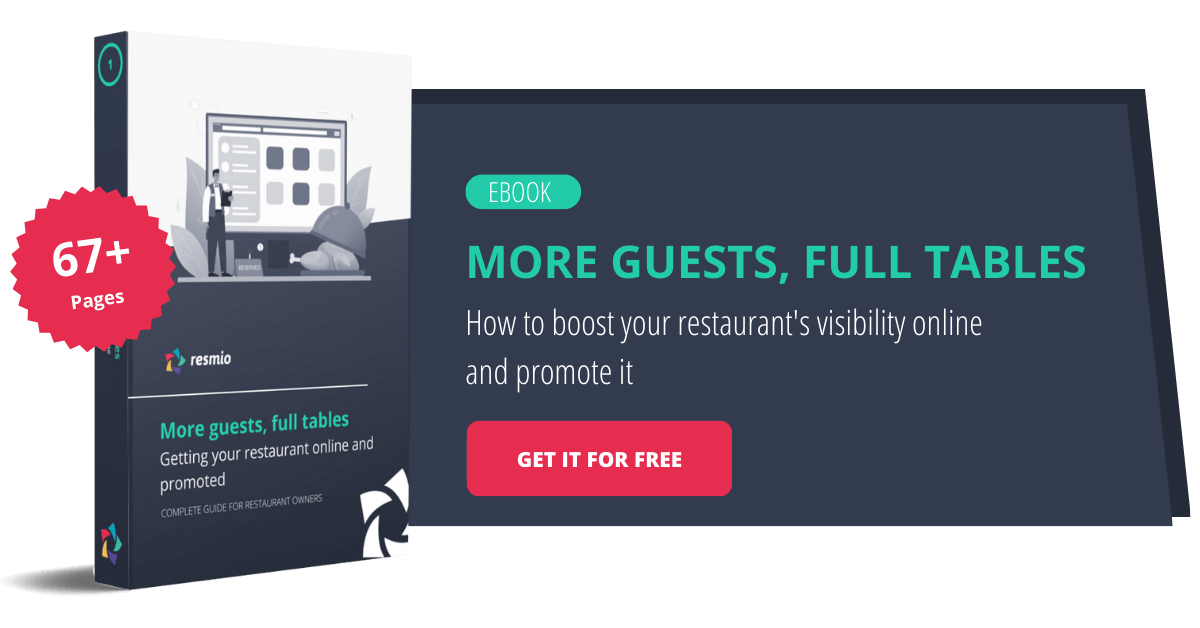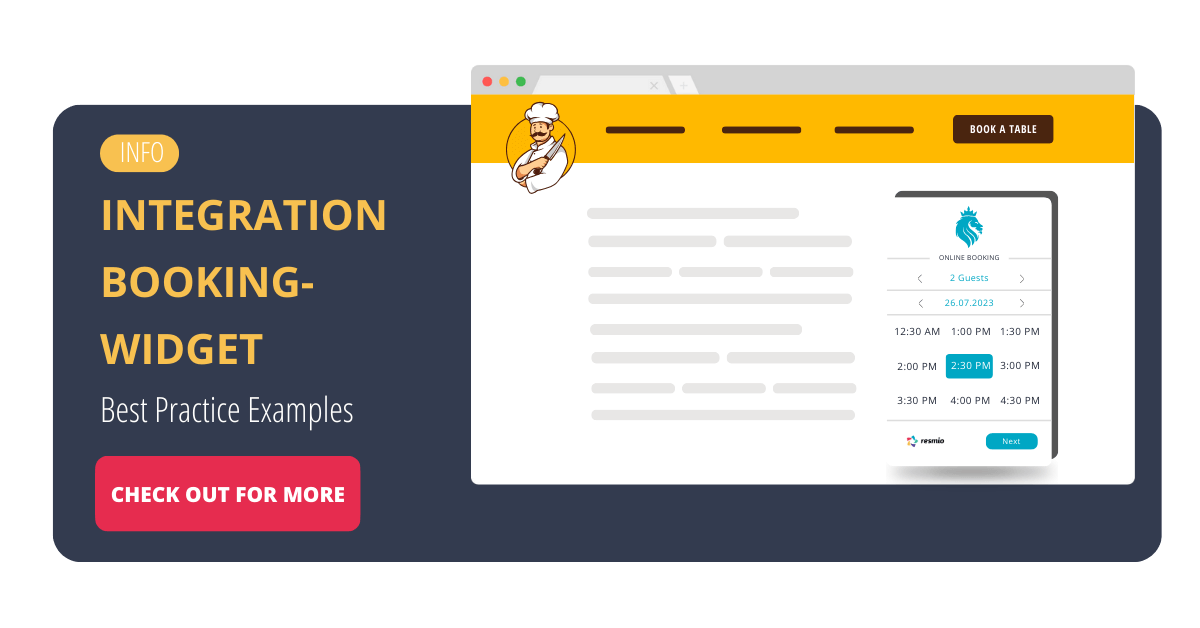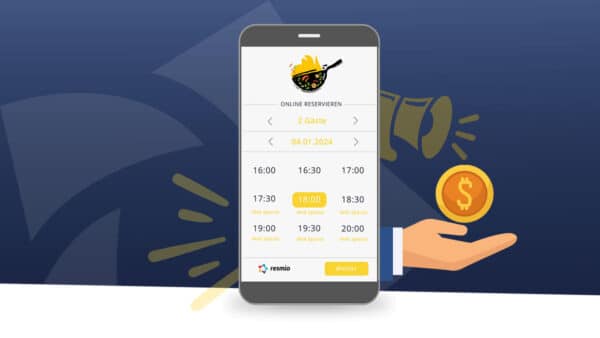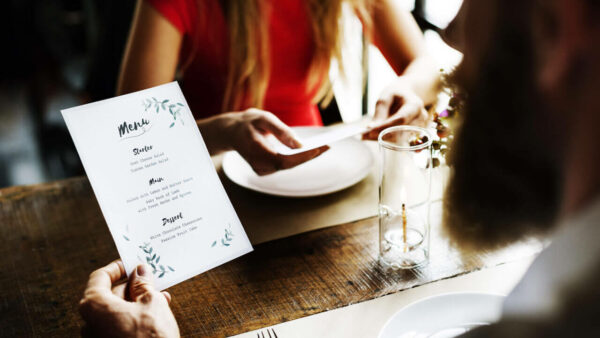Choosing resmio’s table reservation system is just the first step on your journey to become a successful restaurant. Your main objective is to increase online reservations and thus generate higher sales. By optimizing your settings, embedding your online reservation widget and proactive online marketing initiatives, you can influence how you achieve this. We’ll provide you with tips on how to maximize your reservations.
By Max Falkenstern
Table of contents
- Getting the basics right: your reservation settings
- Promo times in your booking widget
- Get the embedding of your widget right
- The sound sets the music: prioritize online reservations
- Raising online visibility of your restaurant
- Send e-mail newsletters to your guests
- Peak time limits and bookings intervals: More reservations despite staff shortages
- Summary – all measures add up to more reservations
Getting the basics right: your reservation settings
We know from previous experience that you can adjust many things in the reservation settings to optimize your restaurant capacity utilization.
However, the devil lies in the detail: seemingly minor tweaks have an impact on your booking rate.
Some key tips:
- Don’t limit your booking capacity by hand – keeping tables for spontaneous diners (“walk-ins”) seems reasonable at first. But the artificially imposed limitation may mean that your restaurant utilization is not as good as it could be without restrictions.
- Think about the following: Shouldn’t your first goal be to get your restaurant fully booked? If you have to reject walk-ins because your restaurant is at maximum capacity (in high demand!), these customers will book early before their next visit.
- Use automated reservation confirmations – If all table bookings have to be confirmed by hand, it costs your staff time and effort. Time which is wasted elsewhere, for example when serving guests. For large group sizes, you can make the appropriate settings in your reservation system (“Automatically confirm reservations up to a group size of _“).
- Set a reasonable length of stay – A low length of stay of 90 to 120 minutes at busy times enables a higher turnover, but can have a negative impact on guest satisfaction. Communicate the length of stay accordingly in the widget and on site through service staff to raise guests’ awareness.
- Minimum group size for reservations – The size should be one or two people if possible. If, for example, only groups of four or more people are allowed to make online reservations in your restaurant, many requests will not even come through.
- Avoid a lot of mandatory input fields – It can make sense for restaurant owners to request additional guest details when making a reservation. But remember that every additional mandatory field makes the booking process more complicated and time-consuming.
Promo times in your booking widget
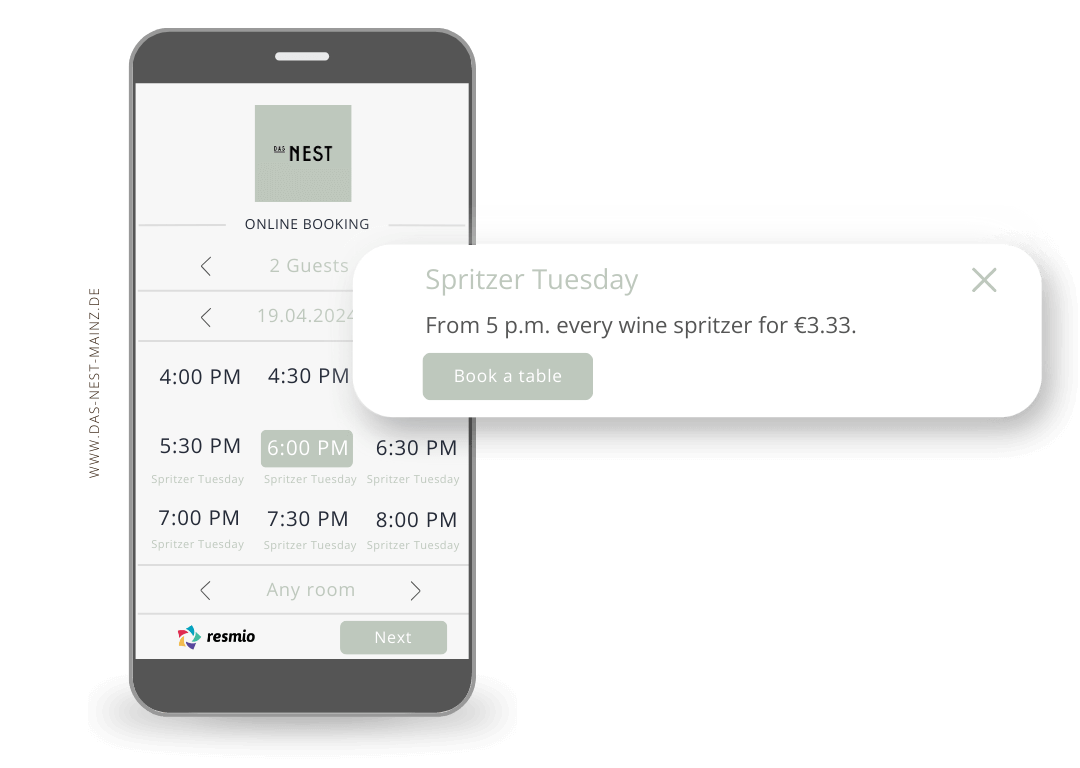
Add promotion times to your online reservation calendar in order to inform guests about special deals and events. These could be regular or recurring events, such as lunch or a happy hour for cocktails.
However, you can also highlight unique deals with a fixed date in your widget. Promotional times are best suited to increasing table bookings at times when capacities are otherwise low. One classic example would be discounted drinks on weekdays or a lunch menu with selected meals.
To maximize the reservation rate, you should use all the marketing channels available to you (website, Facebook, Instagram, Google business profile, email newsletter). Include the direct reservation link to your booking widget in Facebook / Instagram Stories lead potential guests straight to their destination – a restaurant visit!
Get the embedding of your widget right
To boost online bookings for your restaurant, guests first need to know how and where they can book a table in your restaurant. With this in mind, embedding your reservation widget is crucial.
Basically, it is possible to integrate the widget wherever you can set a link. Some examples include your website, social channels and the Google business profile.
Especially on social media, you should always pair direct online booking option with a special deal, e.g. a post about the opening of your beer garden when the weather is nice.
The sound sets the music: prioritize online reservations
Some restaurant owners sometimes make their communication ambiguous in this context. For instance, they embed the reservation widget on the website in an ideal way. However, in a bold notice above it, restaurant operators state explicitly that reservation requests by phone are preferred. In addition, the restaurant still takes bookings by e-mail.
Does freedom of choice always bring better results? Not necessarily.
Customers are quite frankly confused, while restaurateurs are wondering why the rate of online reservations remains low and why the expected impact on reducing staffing and saving time vanishes into thin air.
Let’s get this right: It’s not about cutting off the phone reservation channel for your guests.
The restaurant industry is and will always be a “people business”, and face-to-face communication between guests and hosts is vital.
However, it is possible to “push” your guests into a certain direction. Get them to take a desired action (make an online reservation) in an unforced manner. This is referred to as nudging in specialist terminology.
One feasible option, for instance, is not showing the phone number of your restaurant straight away in the booking context. Your phone number would remain in the footer and on the contact page, leaving this channel still open for your guests.
At the same time, you would (subconsciously) indicate that you wish to receive reservations online.
Raising online visibility of your restaurant
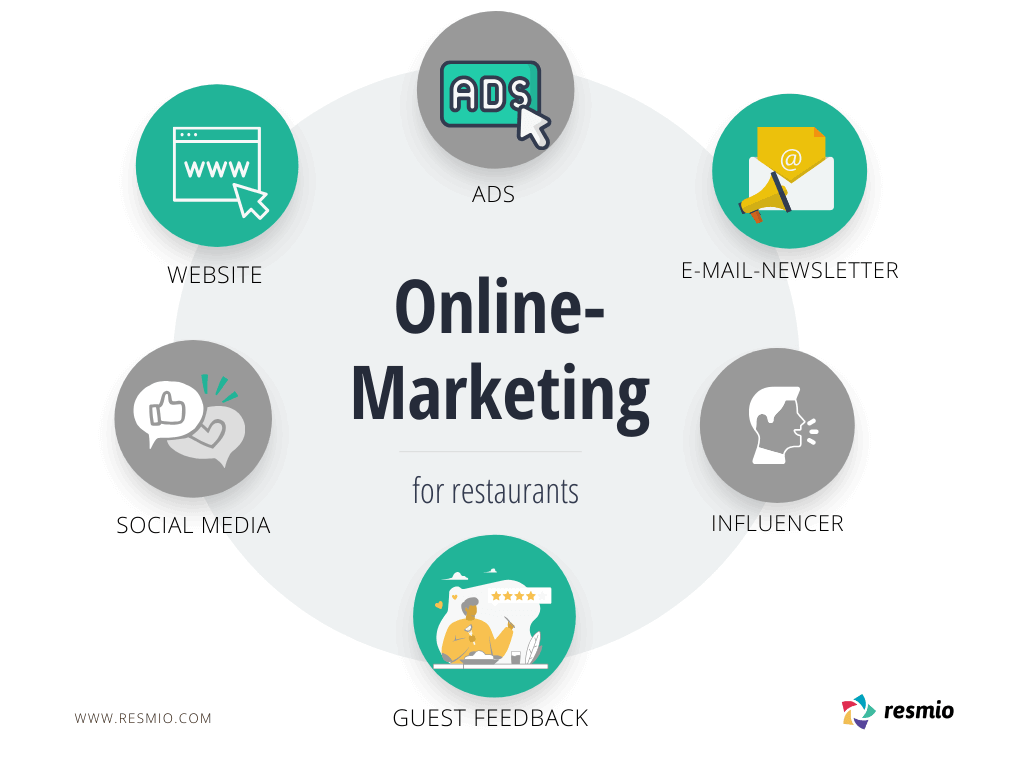
If your restaurants lack an online presence, you will leave many tables empty.
New restaurants in particular need to build a strong reputation online. Your competitors nearby may already have a head start here. And if not, this is your chance to set yourself apart from them.
The following channels should be put to the test:
Google Business profile
Guests prefer to search for restaurants nearby via Google and the Google Maps.
Without a Google business profile, you and your restaurant are almost invisible to potential customers online.
As a first step, you should make sure that the information provided here is complete and up to date.
- Are the contact details correct?
- Are the opening hours accurate?
- Do you have special opening hours for upcoming public holidays?
- Do the business categories listed appropriately describe your restaurant?
- Does the link to the website and menu work?
- Have you selected all applicable offers, features, highlights, food and service options?
Next, you should optimize your restaurant profile on Google so that it best represents your restaurant services.
Only upload high-quality images of food and interior. Use Google’s menu feature to showcase your signature dishes. Provide a short description in your Google Business profile that sets the mood for the restaurant experience in your establishment.
Restaurant website
Having a professional website for your restaurant is a must, not an optional extra.
Because it fulfills two important roles:
- Acquisition of new customers: Prospective customers use your website to find out more about your services – and will ideally reserve a table online.
- At the same time, your website also serves to build customer loyalty. Guests who already know your restaurant will visit your website in anticipation of (hopefully) finding your current weekly menu, news and events there.
If you are satisfied with your existing website, there may still be potential to maximize your restaurant’s visibility.
To name a few: optimizing the meta data, using SSL encryption, setting up a blog for high-reach content and earning so-called “backlinks” for your homepage.
Send e-mail newsletters to your guests
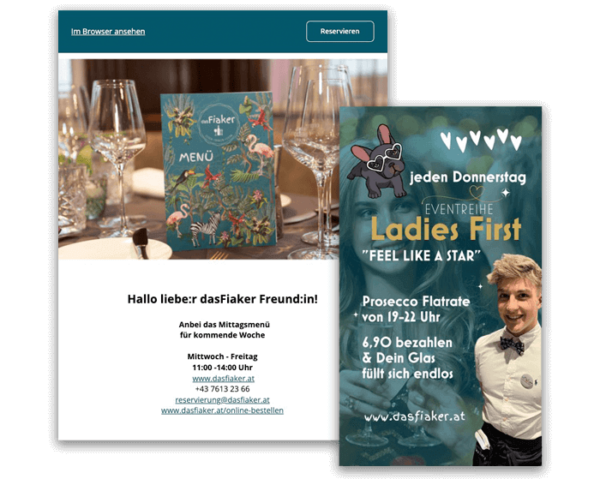
Attracting new customers to a restaurant is more expensive and time-consuming than encouraging regulars to return. In this context, email marketing has proven its worth. And the best thing is: resmio allows you to send newsletters to your guests with ease and minimal fuss.
If you haven’t just started with resmio today, you most likely already have an existing contact list of newsletter subscribers in your guest database – and can start sending emails straight away.
So what kind of content can you send to guests? Promotions, event tips and the current menu are obvious! But you can also include small incentives, such as a discount coupon for a free glass of sparkling wine or an espresso. Not only does this show your gratitude to your guests, the small gifts also encourage them to visit again.
Peak time limits and bookings intervals: More reservations despite staff shortages
While many restaurants would currently like to serve more guests, they are unable to do so. The bottleneck here is a lack of staff – a challenge that restaurateurs are likely to face for years to come.
In other words, the problem lies not in online reservations. Instead, it is the on-site reservation management that is pushing restaurants to their limits.
After all, if there are large gaps in the shift schedule, it makes a significant difference whether there are 100 guests at the door at 2 p.m. or ” just” 20.
The digital reservation system has a perfect answer to this challenge: peak time limits and reservation intervals.
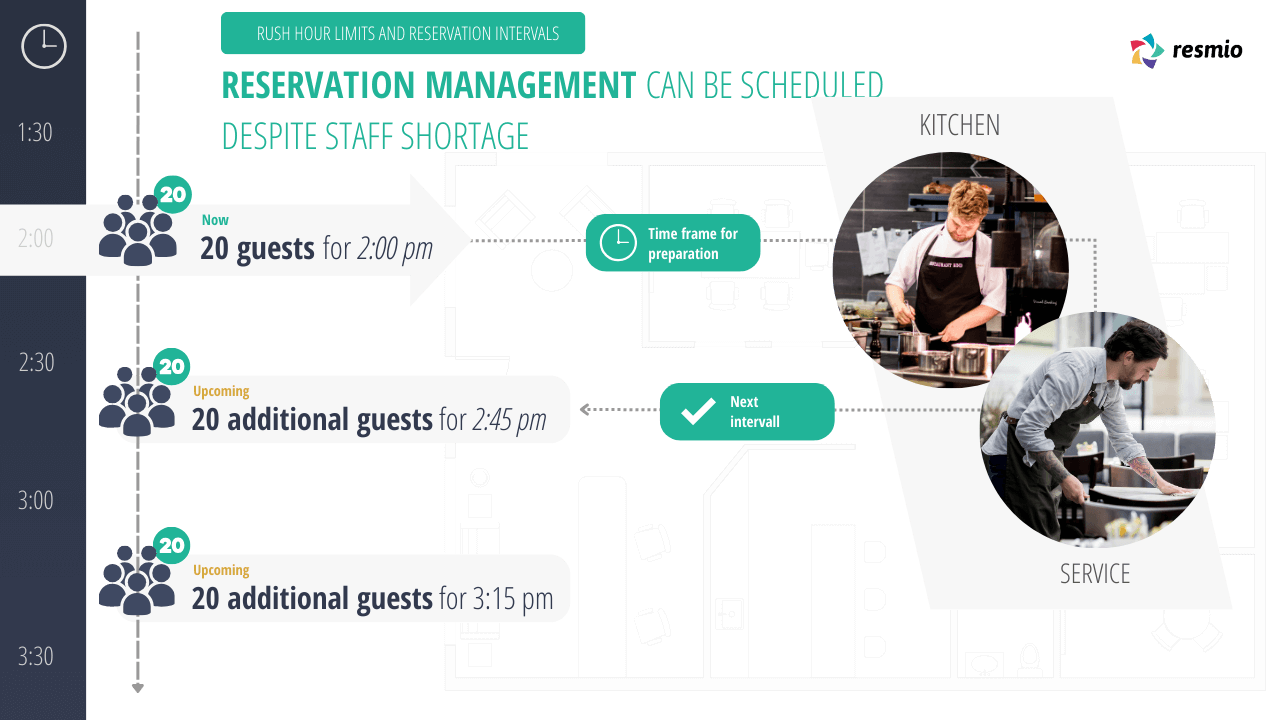
Using the above-mentioned booking settings in your system, you are able to adjust your workload so that the kitchen and service can also process the bookings.
Using our example, we split a large cake in a time frame (100 incoming reservations) into smaller bites that the team can manage (20 guests per 45-minute reservation interval).
From your guests’ perspective, it looks like this: If the reservation block of 20 guests is fully booked at 14:00, there are time slots available for those guests interested at 14:45 (15:15 and so on) according to the interval set.
Your bookings are automatically spread over a longer period of time and the workload remains manageable. In this way, it may still be possible to reactivate the cancelled brunch or lunch service with a small number of staff.
All parties benefit:
- Service and kitchen, because the workload remains manageable and there are no excessive workload peaks.
- Guests benefit because they receive better service and food and drinks arrive on time at their table.
As a result, peak time limits and reservation intervals ensure that you can work flexibly with your existing staff
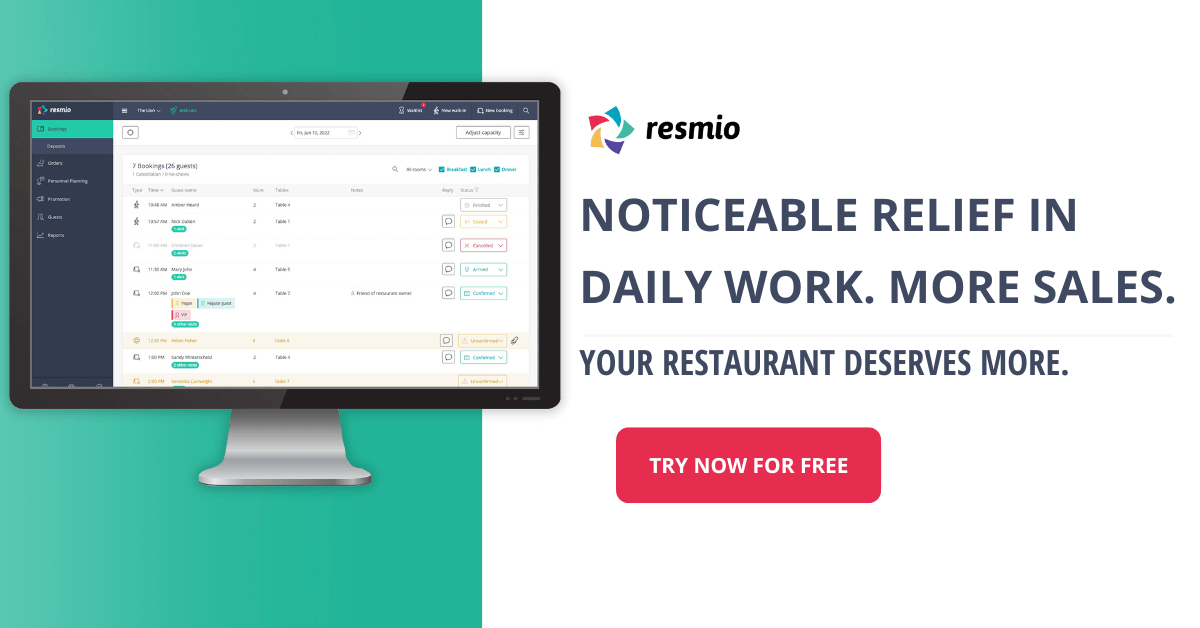
Summary – all measures add up to more reservations
Pull a lever and the restaurant is full of people – it’s wishful thinking. It’s hardly surprising that there isn’t one single way to fill tables as if by magic.
However, with the digital reservation system, you are on the right track.
It is important that your system is set up in such a way that bookings can be generated automatically wherever possible. Many limits that you can set (for obvious reasons) can end up missing important bookings in your day-to-day business. We’ll be happy to advise you in person and answer any questions you may have.
When it comes to marketing your restaurant business online, it is recommended that you cover as many potential touchpoints with your guests as possible. Showcase your dishes, the team, new offers and events on all available channels. Staying on top of things is particularly important here, so make sure you keep in touch regularly.

